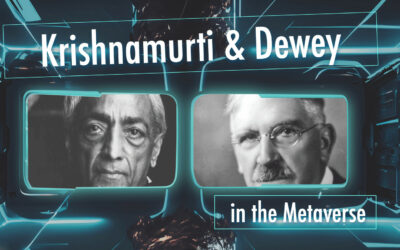I do not know who David Jiles, Ph.D. is. I do know that he is a plagiarist, an intellectual crook and a thief of the highest order!
I do not write these words lightly. I was first informed of this by Mike Deschryver and have over the past few days attempted to look and find out all that I could before making such a strong accusation. The evidence is given below…
Anybody going to the Creativity Portal website (www.creativity-portal.com) would find a link to an article titled Empathizing and Creative Emotion by David Jiles, Ph.D. Following the link leads you to an erudite and sophisticated article that uses examples from art and science to argue that:
To think creatively is first to feel. The desire to understand must be blended with sensual and emotional feelings and whipped together with intellect to yield imaginative insight. Indeed, the intimate connections between thinking, emotions, and feelings are the subject of a startling book called Descartes’ Error (1994), which revisits the famous philosopher’s separation of mind (and thinking) from body (and being or feeling) more than three hundred years ago. The author, neurologist Antonio Damasio, finds that neurological patients whose emotional affect is grossly altered due to strokes, accidents, or tumors lose the ability to make rational plans. Because they are unable to become emotionally involved in their decisions, they fail to make good ones. Our feelings — our intuitions — are not impediments to rational thinking; they form its origin and basis. For Damasio, body and mind, emotion and intellect are inseparable. Not only do scientists feel their way toward logical ideas, but creative thinking and expression in every discipline are born of intuition and emotion.
All very good and wonderful, except that if you open page 5 of a book called Sparks of Genius by Robert and Michele Root-Bernstein you find the following text:
To think creatively is first to feel. The desire to understand must be whipped together with sensual and emotional feelings and blended with intellect to yield imaginative insight. Indeed, the intimate connections between thinking, emotions, and feelings are the subject of a startling book called Descartes’ Error (1994), which revisits the famous philosopher’s separation of mind (and thinking) from body (and being or feeling) more than three hundred years ago. The author, neurologist Antonio Damasio, finds that neurological patients whose emotional affect is grossly altered due to strokes, accidents, or tumors lose the ability to make rational plans. Because they are unable to become emotionally involved in their decisions, they fail to make good ones. Our feelings — our intuitions — are not impediments to rational thinking; they form its origin and basis. For Damasio, body and mind, emotion and intellect are inseparable. We agree. Not only do scientists feel their way toward logical ideas, but creative thinking and expression in every discipline are born of intuition and emotion.
The words in bold are words that have been changed between one text and the next. In fact in the first instance, the only change is that the words “whipped together” and “blended” have been exchanged! In the second instance the mini-sentence “We agree” has been deleted – quite sensible given that the second para was co-authored by two authors and the first one individually by Dr. David Jiles, Ph.D.
What do we make of such a coincidence. Of course there is the Borges short story Pierre Menard, Author of the Quixote in which “20th century French writer who has made an effort to go further than mere “translation” of Don Quixote, but to immerse himself so thoroughly as to be able to actually “re-create” it, line for line, in the original 17th Century Spanish.” (from Wikipedia).
I guess Dr. David Jiles Ph.D. has so immersed himself in the minds of Root-Bernstein and Michelle that he has re-created this paragraph, line for line.
How far does this mind-meld go? A bit of Internet sleuthing reveals the following about Dr. David Jiles, Ph.D.
While completing his doctorate, David Jiles has worked as a consultant for many Fortune 500 companies as well as the United Nations helping them to solve a variety of very unusual problems. In his book, Creativity and the Secret Language of the Mind (LuLu Press, 2007), he suggests that we need to re-think thinking; to better understand the process of creativity. His research includes the study of the world’s most popular creative artists: daVinci, Einstein, Hemingway, Picasso, Tesla, Beethoven and countless others to find common secrets towards creative thinking; and HE FOUND THEM. Creativity Portal is happy to share those exciting secrets in a series of articles. David may be contacted at david50jiles@gmail.com.
That was good to know, and I was impressed. Consultant, author, researcher on the world’s most creative artists! Wow. The Creativity-Portal page also lists a series of articles by Dr. Jiles based on his book. And the article titles are as follows:
Rethinking Thinking, Observation, Creative Imaging and Enhanced Insight, Creative Abstracting, Creativity in Pattern Recognition, Analogizing, Body Imagination, Empathizing and Creative Emotion, Dimensional Thinking, Creative Modeling, The Role of Playing in Creativity, Our Dreaming Mind
A quick peek at the Sparks of Genius book reveals the extent of the mind-meld that has been achieved. The chapters in this book are:
Rethinking Thinking, Schooling the Imagination, Observing, Imaging, Abstracting, Recognizing Patterns, Forming Patterns, Analogizing, Body Thinking, Empathizing, Dimensional Thinking, Modeling, Playing, Transforming, Synthesizing, Synthesizing Education
The mapping between the chapters is uncanny. And what is the most astounding is once you peek into the chapters. Paragraph by paragraph has been lifted from the Sparks of Genius book – with never a mention of credit given to them.
Let’s take one at random: How about “The Role of Playing in Creativity.” This piece starts like this:
In 1936 medical researcher Alexander Fleming gave two demonstrations at the Second International Congress of Microbiology in London. In the first he presented his discovery of an odd mold called Penicillium, which produced a compound that inhibited the growth of various infectious bacteria. In the second he discussed his odd invention of microbe painting, in which various pigmented bacteria were carefully brushed with a wire loop onto agar plates, producing a pleasing picture. The scientific world ignored both presentations. Fleming did not make a convincing case for Penicillium, nor had he worked any miracle cures with it.
Now is the first paragraph from Root-Bernstein’s book from the chapter titled Playing:
In 1936 a relatively obscure medical researcher named Alexander Fleming gave two demonstrations at the Second International Congress of Microbiology in London. In the first he presented his discovery of an odd mold called Penicillium, which produced a compound that inhibited the growth of various infectious bacteria. In the second he discussed his odd invention of microbe painting, in which various pigmented bacteria were carefully brushed with a wire loop onto agar plates, producing a pleasing picture. The scientific world ignored both presentations. Fleming did not make a convincing case for Penicillium, nor had he worked any miracle cures with it. And Queen Mary has summed up the response to bacterial paintings a short time before, when she was shown a moldy Union Jack that Fleming had prepared for her visit to the hospital where he worked. “Yes, but what good is it?” she had asked. She might as well have asked, “What good is play?”
Now on to the second paragraph. Instead of making you read the text twice, I am just going to keep the Root-Bernstein text and bold the words that disappeared in David Jiles’s Ph.d.’s version.
Everyone who knew Fleming knew that he liked to play. He was a brilliant student, a hard-working scientist, and one of the first to adopt Paul Ehrlich’s “magic bullet,” Salvarsan—the first totally synthetic drug—for treating syphilis. But Fleming He always made time for sports and games of all sorts: rifle shooting, golf, billiards,croquet, penny pinching, checkers, bridge, poker, quiz games, table tennis, water polo… and he did not always play by the rules either. He found delight, according to one friend, in “making difficulties for himself, just for the fun of overcoming them.” He would play a round of golf with only one club or, lying on the ground, use the club as a billiard cue to putt. He devised various indoor golf games for the amusement of children. He thought nothing, one biographer has written, of interrupting an evening conversation with distinguished bacteriologists to organize a game of shove-ha’ penny. Nor did Fleming confine his playful spirit to after-hours only. He played at work — or more accurately, he played with his work. “You treat research like a game,” his boss, Sir Almroth Wright, once said to him, “You find it all great fun.”
Three things worth noting.
First, at no point does David Jiles, Ph.D. ever write an original sentence. He deletes sentences and phrases that don’t work for him – or that seem essentially digressive. So this is not plagiarism in the sense of close paraphrase, or an occasional copy and paste. This is whole-sale LOOTING! Mind boggling in its absolute sense of chutzpah.
Second, the two paragraphs have exactly two words that David Jiles, Ph.D. added to the text. They are highlighted in red and are “he” and “and.” How is that for creativity and originality.
Finally, note the (1) at the end. Turns out that David Jiles, Ph.D. does provide citations when he quotes and cites someone. Who would have thunk it!
Just in case you think that the above examples are exceptions to the role. Not so. The same pattern can be found in almost every chapter that is available online. I have downloaded all the chapters onto my computer and am willing share them with anyone who seeks to check it out.
Who published the book
I have not bought this book, since I didn’t want David Jiles Ph.D. to profit form his crimes. If there is anybody out there who has bought this book and is willing to share it with me, do drop me a line.
The book that David Jiles Ph.D. claims to have authored can be bought from Lulu Press for approximately $20. A bit of research reveals that Lulu Press is a place where anybody can send in some files and get published. There is no editorial review, at least none that I could find…
You can find out about the book by going here or more about Lulu Press by going here.
My internet research revealed that David Jiles Ph.D. had peddled his wares at other websites as well, and those writings, as far as I could see, are stolen as well. Some links that I found are given at the end of this posting.
So who is David Jiles, Ph.D.?
UPDATE: I had a section here where I spoke of a result of a Google search and linked to some people whose names showed up. Mike Deschryver pointed out to me that he could see himself “being a bit peeved” if I linked to someone without getting their consent first. He is absolutely right. I am sorry I didn’t think of this earlier. I have deleted this text.
The original Sparks of Genius
Sparks of Genius is a wonderful book. I have had it for years and I am using it as a textbook in my Creativity in Teaching and Learning course this semester. Robert Root-Bernstein is a professor of physiology at Michigan State University, a MacArthur Fellow (popularly known as the Young Genius awards). His homepage is here. Michele Root-Bernstein (home page here) is an adjunct Instructor in the Department of Theatre at MSU.
To see all the hard work put in by the Root Bernstein’s stolen in such a blatant manner just blows me away. This is clearly the most egregious example of plagiarism I have seen and deserves the utmost condemnation. As and academic I live in a world of ideas… and the only cachet I have is that my ideas be my own and that others, when they use them, provide proper citation. This is something David Jiles, Ph.D. has failed to do. He is a thief and I hope this article unmasks him to be a total and complete fraud.
To find out more about academic definitions of plagiarism please visit this site at Princeton University, one of the best places to gain a better understanding of these issues.
Finally…
I haven’t contacted Dr. David Jiles, Ph.D. as of yet. I will do so once this article is written and posted. I am also going to email the people who have hosted his articles – asking them to take them down, and to post a note indicating that they were fooled by this person and a link to this posting (as a warning to other individuals who may be thinking of trying something similar). Otherwise I will conclude that they are party to this deception as well… something I will report here.
As I have written earlier, I have archived all the pages “authored” by David Jiles, Ph.D. on my computer and am willing to share them with anyone who wishes to check the claims I am making.
This and that:
Other places David Jiles, Ph.D. has published his works
Two articles on the website Innovation Tools: Intuition and emotion in creative thinking and The role of play in creativity
One article on Brain Bank: Creative Imaging and Enhanced Insight
[UPDATE: The editors of Brain Bank got back to be right away, and it seems to me that they were NOT in anyway involved in this act of plagiarism. They were victims of this, as much as the Root-Bernsteins and other visitors to their website]
Three articles at Young Bright Minds & Inventors Academy: Creativity in Pattern Recognition; The Creative Translation Process; and Dimensional Thinking
An article on a blog (that the blogger, Syed Kamarulzaman, may have just copied from somewhere else – though he does give credit to David Jiles Ph.D.): Intuition and Emotion in Creative Thinking
David Jiles, Ph.D. has also been cited by other websites:




Thank you Dr Mishra. I will be alert. As a lecturer in a higher education establishment, we have our fair share of struggle in helping our young students steer clear away from plagiarism.
Thanks Ivan.
As a scholar and an author, I am appalled at the blatant disrepsect that this David Jiles has shown for original work. He shouldn’t have lasted two seconds in any respectable graduate institution. Makes me wonder what happened. Bravo Dr. Mishra! For standing up for what is right. The world (even if a small part of it) will be better for it.
Wow! Ok so I don’t actually KNOW these people but I, of course, know the resource and I too am astounded. I’ll stay posted to watch where this leads. Kudos to you and Mike for taking this seriously and “calling” David Jiles out on this. It certainly puts a slant on the meaning of creativity and patterning as well!